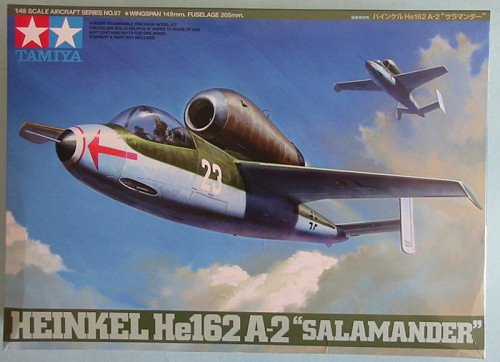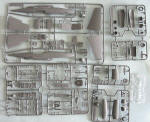
| KIT: | Tamiya 1/48 He-162A-2 'VolksJaeger' |
| KIT #: | 61097 |
| PRICE: | 2400 yen from www.hlj.com |
| DECALS: | Four options |
| REVIEWER: | Tom Cleaver |
| NOTES: | New Mold kit |

| HISTORY |
The Heinkel He-162 fighter is a perfect demonstration of the dream world Hitler and his Nazis lived in. Had the leadership of Germany been willing to see the writing on the wall even as late as “Big Week” in February 1944 and conclude that Germany needed to put all its resources into defense, this airplane might have had an effect on the Second World War, though the ultimate result would have been merely to delay the inevitable by at most 18 months. In the space between February and September, when reality was finally confronted, such was the pace of Allied success with the invasion of Normandy and the expulsion of German forces from all Soviet territory on the Eastern Front that the die had been cast and there was nothing to be accomplished in the production of the aircraft.
The main claim to fame of the He-162 was the phenomenally short time that elapsed from its conception to the flight of the first prototype - just less than three months. The airplane was born of the necessity to create an interceptor with the performance of the Me-262, costing less and using non-essential materials, to be of such simple design that it could be rapidly produced by semi-skilled labor.
The specification for what would become the He-162 was issued on September 8, 1945; it called for an aircraft that would be regarded as “a piece of consumer goods”, that would be ready to enter operational use by January 1, 1945. Seven companies were invited to submit proposals - Arado, Blohm und Voss, Fieseler, Focke-Wulf, Heinkel, Junkers and Messerschmitt. Messerschmitt flatly refused to participate, leaving Heinkel as the only competitor with any actual jet aircraft design experience, having built the world’s first jet, the He-178, and first jet fighter, the He-280.
The designs submitted by Heinkel and Blohm und Voss were judged best on September 15, 1944, though the Blohm und Voss project would be abandoned on September 30. Heinkel completed final design work on September 23, and a small mock-up was inspected by the RLM. This was followed by the award of a contract for 1,000 He-162s per month, with mass production to begin no later than January 1, 1945.
All design work was completed by October 29, when the blueprints and drawings were sent to the workshops, and production of the prototypes commenced.
The He-162-V1 took to the air for its first flight on December 6, 1944. The official first flight took place on December 10, before many Luftwaffe officials. As Chief test pilot, Flugkapitaen Peter came across the field in a high-speed run, the starboard wing leading edge split, the aileron and wingtip tore away, and the prototype executed three quick rolls before crashing in front of the audience. Three more prototypes and 30 He-162A-0s entered flight test between December 15, 1944, and February 28, 1945. As a result of these tests, several modifications were adopted, including lengthened and down-turned wingtips, turning up the wing root, and placing spoilers on the leading edge near the fuselage. The rudders were also enlarged to provide directional stability. With these modifications, the flight characteristics were much improved, but it was obvious that the Nazi plans of sending thousands of ill-trained Hitler Jugend aloft in this demanding airplane were another fantasy.
Operational testing of the He-162 was assigned to Erprobungskommando 162, under the command of Heinz Baer at Rechlin. I/JG1 left the Eastern Front on February 6, 1945, to convert onto the He-162A-2 at Parchim. On completion of training on April 8, 1945, the unit transferred to Ludwigslust, while II/JG1 was transferred to Warnemuende in late March to commence conversion training. While there is a rumor that an He-162A-2 of I/JG1 may have shot down an RAF Tempest in the last week of April 1945, there is no firm evidence of the He-162 ever entering combat before V-E Day on May 8, 1945. (Editor's Note: the recent book by Alfred Price, Battle over the Reich volume 2, states that there is evidence confirming that the 162 had several victories in combat and pilots were given credit for kills. I'm sure this will generate some discussion!)
The British captured the 50 aircraft of I/JG1 at Leck on May 8. By this time, over 1,000 He-162s had been produced in two underground factories, but Germany was too chaotic for them to get from factory to front line.
Ten He-162s were brought to England after the war, where several were tested and a British test pilot was killed in one in November 1945 due to engine failure at low altitude. Three of these were sent on to the United States and tested at Freeman Field, Indiana in 1946. Wk. Nr. 120077 went to Muroc Field in 1947, and was sold from there to a private collector as scrap in the early 1950s. In 1958, Ed Maloney, founder of The Air Museum, Planes of Fame, began negotiations to purchase this airplane, and it arrived at the museum in 1961. Today, this He-162 is one of the first aircraft a visitor sees on entering the Museum grounds in Chino, California.
| THE KIT |
 The Previous 1/48 He-162 is that originally released by Trimaster and later DML,
about 15 years ago. That kit, while a bit “fiddly” certainly made up into a
nice model of this little airplane. Unfortunately, it’s long been out of
production. Thus, this release by Tamiya can be seen as an “update” that also
“Tamiyanizes” the kit design. In no way is this the Trimaster-DML kit as some
of the “expert geniuses” on a certain scale muddling discussion board have
claimed. It is entirely new and entirely Tamiya in origin.
The Previous 1/48 He-162 is that originally released by Trimaster and later DML,
about 15 years ago. That kit, while a bit “fiddly” certainly made up into a
nice model of this little airplane. Unfortunately, it’s long been out of
production. Thus, this release by Tamiya can be seen as an “update” that also
“Tamiyanizes” the kit design. In no way is this the Trimaster-DML kit as some
of the “expert geniuses” on a certain scale muddling discussion board have
claimed. It is entirely new and entirely Tamiya in origin.
I
have seen comments by another modeler that this kit differs somewhat in various
dimensions from the earlier kit - i.e., smaller-span tailplanes, different-size
vertical fins, more bulbous nose, etc. I suspect the difference is that the
Trimaster kit was done from drawings, while this kit was done from actual
measurement of Wk. Nr. 120077 out at the Planes of Fame Museum in Chino, since I
know for a fact representatives from Tamiya were out there in 2 004
measuring several airplanes and photographing them in detail. Thus, my bet is
that this kit is overall more accurate than the older kit.
004
measuring several airplanes and photographing them in detail. Thus, my bet is
that this kit is overall more accurate than the older kit.
Looking in the box, the kit provides a nicely-detailed cockpit that only the certified resinaholics will have to replace, though a resin seat with molded-in seatbelts would definitely improve things. The engineering of such things as the landing gear are simplified to be less mistake-prone than the parts from the earlier kit.
The engine is provided in detail, and a modeler will have the option of displaying the nacelle both open and closed, since the two different nacelles will fit to the rest of the model in a modular manner and can be interposed with each other.
Decals are provided for four He-162s: that flown by Oblt. Helmut Demuth, “Yellow 11" of 3/JG1; that flown by Ltn. Rudolf Schmitt, “White 1" of 1/JG1; and the well-known “Nevenklau,” Wk. Nr. 120077, flown by Ltn. Gerhard Hanf of 2/JG1, which is on display at Planes of Fame. “White 23" is also included, to be done as the boxart airplane.
A round weight is provided to guarantee nose-sit.
| CONCLUSIONS |
Tamiya’s He-162 looks to be a very easy model that will present no problems in assembly and will look good when completed. This would be a good first kit for someone returning to the hobby after an extended absence, given the ease of construction.
May 2006
Review kit courtesy of HobbyLink Japan. Get yours at www.hlj.com
If you would like your product reviewed fairly and quickly by a site that has over 300,000 visitors a month, please contact me or see other details in the Note to Contributors.